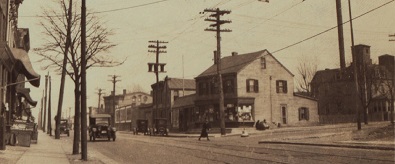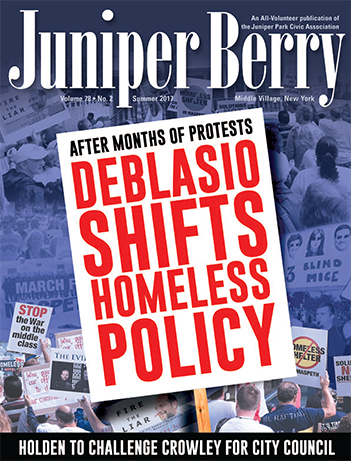Herman Ringe was quite the man about town. Today, it would be multiple towns. He was born in 1876 and lived his entire life in an area known as “Metropolitan” which was situated between Fresh Pond Road and Flushing Avenues on both sides of Metropolitan Avenue. (The area is now evenly split between Maspeth and Ridgewood.) His family owned a general store at the corner of Forest and Metropolitan Avenues.
Ringe had worked as a clerk in the Queens Tax Office until 1906 when he became secretary to Queens Borough President Joseph Bermel, who resided in Middle Village. He also was Chief Clerk of the Highways Department. In 1908, he formed a real estate and insurance brokerage, in which he later partnered with his son, Herman Jr. Their office was located at 58-02 Metropolitan Avenue near the corner of Forest Avenue and next to the family store. Decades later, a brick office building was built at the corner to house the real estate office and it sported an iconic clock that many area residents remember fondly.
In his youth, Ringe had joined the Newtown Fire Department, the volunteer force that predated the FDNY in our area. He worked out of the Metropolitan NFD #12 house, which was located just east of Forest Avenue, around the corner from where he lived and down the block from the family store. By the time the FDNY took over in 1913, Ringe had attained the rank of chief. At a reunion in 1948 that was covered by the Brooklyn Daily Eagle, he recalled an incident that occurred in 1902:
“It was the custom, before we had our own horses, to have horses come in from neighboring stables and draw the apparatus at a fixed fee,” he recalled. “The drop harness was always in position so that when the horses were brought in they went immediately to their places. The harness was made in only one way – large. But on this occasion one of the team was what we called at that time a carriage horse. I was the driver, and as we sped up Forest Avenue atop the old steam pumper, I turned to the chief and told him that the harness would not stay put. The chief gave one command, and I had to crawl out upon the wagon pole, even though the horses were galloping at top speed, and hold the harness into position until we reached the fire. It was certainly a wonderful sight to see a team of powerful horses gallop down our street, drawing the apparatus.” He shook his head sadly. “When the paid department took over and motorized equipment was installed, it took away that glamour.”
Herman Sr. became consolidator of the Ridgewood Savings Bank and in 1944 was elected its president. He also was vice president of the Wyckoff Heights Hospital, director of both the Queens and Ridgewood Chambers of Commerce, and a trustee of Lutheran Cemetery and the Queensboro Elks.
Ringe Sr. was past president of the Ridgewood-Metropolitan Civic Association and a member of the Queens Planning Commission when he was asked to speak at the grand opening of Eliot Avenue in February 1939. The December 2000 Juniper Berry remembered the event as follows, “He spoke of the improvement as a ‘dream of twenty-five years come true.’ He cited the fact that he and other property owners in the vicinity had been assessed for the thoroughfare fifteen or more years ago. Alluding to the thoroughfare as a direct connecting link to the World's Fair, Mr. Ringe declared that the opening of Eliot Avenue represented one of the outstanding improvements in the history of the community.”
In 1946, Ringe suffered a great personal tragedy when his son and business partner, Herman Jr., passed away. Almost immediately after that, the City of New York came after his property. The house in which he had lived his entire life, located at 62-35 Forest Avenue, was under threat of condemnation in order to allow the extension of Greene Avenue through to Metropolitan Avenue. Ringe was at a hearing at Lost Battalion Hall in 1948 preparing to defend his home when he suffered a fatal heart attack at the age of 72. More than 400 people attended his funeral at the Old First Presbyterian Church on 60th Place near Metropolitan Avenue.
Greene Avenue was never cut through Herman Ringe’s property although it remains marked on official zoning maps. A Walgreens now occupies the site of Ringe’s home and its parking lot replaced his office.
Before his death, the “Herman Ringe Bridge” was dedicated in his honor. It is located on 60th Street in Maspeth over the LIRR tracks. Sadly, the official name appears only on city planning maps and not on the bridge itself.




